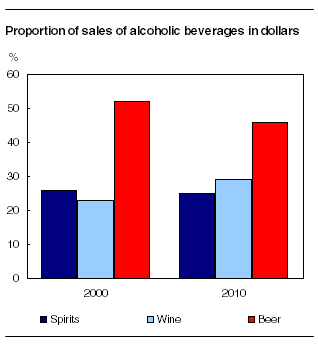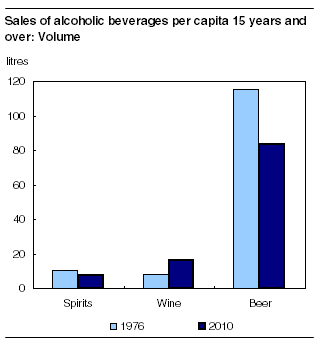Control and sale of alcoholic beverages
Archived Content
Information identified as archived is provided for reference, research or recordkeeping purposes. It is not subject to the Government of Canada Web Standards and has not been altered or updated since it was archived. Please "contact us" to request a format other than those available.
Related subjects
-
[an error occurred while processing this directive]
Beer and liquor stores and agencies sold $19.9 billion worth of alcoholic beverages during the fiscal year ending March 31, 2010, up 2.8% from the previous year. Beer remained the alcoholic drink of choice for Canadians.
The growth in dollar value reflected a combination of factors, including an increase in sales of imported wine and beer as well as a 1.1% average increase in alcoholic beverage prices during the fiscal year.
In litres of absolute alcohol, the volume of sales of alcoholic beverages increased 1.3% to 229.5 million litres.
The net income realized by provincial and territorial liquor authorities, combined with other alcohol-related revenue, such as liquor licenses and permits, reached $5.6 billion in 2010, up 2.5% from the previous year. British Columbia reported a decline of 1.5% in net income, while the rest of the provinces and territories experienced growth.
Beer: Imported brands still on the rise
Beer and liquor stores and agencies sold $9.2 billion worth of beer during the fiscal year ending March 31, 2010, up 3.8% from the previous year. Newfoundland and Labrador had the largest increase in sales at 14.7%.
Although beer remained the alcoholic drink of choice in terms of both volume and dollar value, its dominance continued to decline as consumers turned more to wine.
A decade ago, beer had a market share of 52% in terms of dollar value, compared with 23% for wine. By 2010, the market share for beer had declined to 46%, while wine accounted for 29%.

Note to readers
Statistics on sales of alcoholic beverages by volume should not be equated with data on consumption. Sales volumes include only sales by liquor authorities and their agents, and sales by wineries and breweries and outlets that operate under license from the liquor authorities.
Consumption of alcoholic beverages would include all these sales, plus homemade wine and beer, wine and beer manufactured through brew-on-premises operations, sales in duty-free shops and any unrecorded transactions.
Similarly, statistics on sales of alcoholic beverages by dollar value of sales should not be equated with consumer spending on alcoholic beverages. Sales data refer to the revenues received by liquor authorities, wineries and breweries. These revenues include sales to licensed establishments, such as bars and restaurants.
Therefore, sales data do not reflect the total amount spent by consumers on alcoholic beverages, since the prices paid in licensed establishments are greater than the price paid by those establishments to the liquor authorities.
Per capita data are based on the population aged 15 and over.
Volume of sales of alcoholic beverages in litres of absolute alcohol is calculated by multiplying the sales volume by the percentage of alcohol content. For more information on conversion rates, consult the 'definitions, data sources and methods' section of this release.
In terms of volume, beer stores and agencies sold 2.4 billion litres of beer in 2010, up 1.4% from the previous year.

On a per capita basis, beer sales amounted to 83.6 litres per person in 2010, down from 85.6 litres in 2000. In contrast, during the same period, beer sales in terms of value increased by almost $53 to $326.4 per person.
The growth in volume of sales of imported beer continued to outpace that of domestic products. The volume of imported beer sold increased 7.8% in 2010, while volume sales of domestic products were up (+0.4%).
In 2010, imported beer captured 14% of the beer market in Canada, double its market share of 7% in 2000.
Of all the imported beer sold in Canada, 24% came from the United States, 20% from Mexico and 17% from the Netherlands.
Wine's popularity still on the rise
Wineries and liquor stores and agencies sold $5.8 billion worth of wines during the year ending March 31, 2010, up 3.1% from the previous year.
In terms of volume, wine sales reached 456.5 million litres in 2010, a 3.4% increase from 2009. The growth in sales of imported wine (+3.8%) outpaced the growth of domestic wine sales (+2.9%).
Much of the strength in wine sales can be attributed to the rising popularity of red wines. Sales of red wine, which includes both red and rosé wines, accounted for almost 62% of the total volume of red and white wine sold.
Dollar sales of red wine more than doubled (+168.9%) between 2000 and 2010, while dollar sales of white wine rose at a much slower pace (+56.4%) during the same period. Just over 75% of all red wines sold in Canada were imported, compared with 61% of white wines.
Spirits: Imported products capturing greater market share
Liquor stores and agencies sold $4.9 billion worth of spirits during the year ending March 31, 2010, up 0.7% from the previous year. This gain was mainly due to a 4.3% increase in vodka sales and a 3.0% gain in rum sales.
The volume of spirits declined 0.4% in 2010 to 209.5 million litres. Over the past decade, domestic spirits dominated the spirits market, but their lead has been declining.
In 2000, domestic products represented 74% of total volume of sales; by 2010, they accounted for 68%.
Over the past 10 years, the market share in terms of dollar value of whisky-type products, such as whisky, scotch and bourbon, has declined. However, whisky-type products continue to have the largest share, accounting for 27% of total spirits sales in 2010.
In contrast, strong vodka sales closed the gap with whisky sales in 2010, capturing nearly 23% of market share, up from 18% a decade ago. Much of this strong growth in vodka sales is attributed to imported brands, which have almost doubled their market share from 19% in 2000 to 35% in 2010.
Available on CANSIM: tables 183-0006 and 183-0015 to 183-0020.
Definitions, data sources and methods: survey number 1726.
Data tables on sales of alcoholic beverages are available from the National economic accounts module of our website.
Data are also available through custom and special tabulation. For more information on products and services, contact Client Services (613-951-0767; pssd-info-dssp@statcan.gc.ca). For more information, or to enquire about the concepts, methods or data quality of this release, contact Luqman Rana (613-951-3524; luqman.rana@statcan.gc.ca), or Fadi Ibrahim (613-951-3565; fadi.ibrahim@statcan.gc.ca), Public Sector Statistics Division.
- Date modified:
